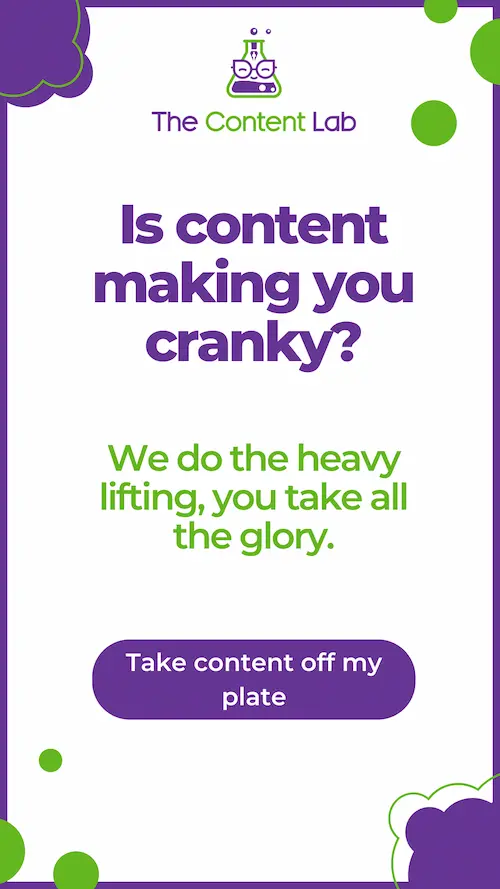With clients slowly going quiet over the holidays and with the new year fast approaching, you’re probably thinking about your marketing strategy to get those red hot leads through the door and filling up your pipeline for the next few months.
A huge part of promoting your business is having a solid content strategy in place. Don’t tune out or click away, stay with me! Creating a content strategy isn’t as intimidating or as boring as you might think.
Now I know not everyone LOVES creating content as much as I do, but today I’m going to show you exactly how to create a pretty solid plan for your content marketing for the next few months.
While I can’t guarantee you’ll fall in with content, this article should hopefully demystify the whole ‘content strategy’ thing for you and make your new year planning a little less of a headache.
Here’s how to create a content strategy for your web design business, or maybe even a client or two.
What’s the point in creating a content strategy?
TLDR: it makes the rest of your year so. much. easier. No more scrabbling around trying to come up with a random blog post to write.
Instead of being reactive (hello stress) a content strategy empowers you with a proactive plan of what to post and when.
Almost 80% of B2B marketers have a content marketing plan, but only 43% of them actually document their strategy. Having a set content strategy in place helps you stay focused on the end goals of your content, and documenting helps make sure everything gets completed on time.
A full content strategy includes every part of your company’s content – both offline and online, written, graphics, video, and any other medium you use.
Many web agencies create a partial content strategy, which can focus on a mix and match combination of blogs, social posts, email marketing campaigns, ad campaigns, and lead magnets.
What you choose to do completely depends on your needs, your target audience, and your budget (what that’s your own time or paying someone else to do the content for you).
No matter the scope of your work, a content strategy includes:
- Planning your content – researching what works, figuring out what doesn’t, when to publish, and where to publish
- Creating content – writing the content or hiring a content writer to do it for you
- Delivering content – getting the content finished on time so you can upload it to your website’s blog, send it out in an email, or post it to your social media
- Measuring your content’s performance – keeping track of how well your content is doing, how many leads it’s generating, and how many people are engaging with it
- The governance of content – creating detailed plans on how each type of content is created, updated, and monitored – and who’s responsible for what
Ok, now we’ve covered what a content strategy actually is, let’s take a look at how to create your own.
How to create a content strategy that works for your company
There are six critical steps in creating a content strategy for your company. While there’s only six main steps, each is pretty in-depth with many different working parts to it. But I’m going to break down each into bite-sized, non-scary chunks. Remember – no two companies are the same, so do what feels right for your needs and bandwidth.
1. Identify Your Goals
The first step to creating a content strategy is to identify your goals and figure out exactly who your target audience is. Sounds simple but there’s a bit of work that goes into both these things.
Here are a few questions to ask yourself when figuring out your goals:
- How will you define your strategy’s success?
- Are you looking for:
- Leads
- Authority and brand awareness
- Increased web traffic
- Customer conversions/sales
- What are the mediums that work best for you and your audience?
- Where are you publishing your content?
And a few questions to consider about your ideal clients:
- Who are they? What industry are they in? What is their position in the company?
- What are their problems? How do you solve them?
- What are they looking for? What are they searching for online?
- How do you make their life better?
- Where do they hang out online?
- What makes them buy in?
- What do they value in a business partner?
- How do they like to consume their content online?
Whenever I’m working on my own strategy, I start by writing down all the questions I’ve been asked on calls with new/potential clients, then expand on those topics.
Doing an in-depth deep dive like this will help you evaluate your company’s brand positioning, what you stand for, and where you want to take things in the next year.
2. Research
First, take a look at how your website is currently doing. Go ahead and analyse your rank on Google, what pages and blogs of your website are ranking (and converting), what they’re ranking for, and see what you’d like to improve on. Focus your improvements on areas that align with your business goals.
Depending on where you are as a company, you might already have extensive insight into your ideal client – so you’ll just be expanding (or updating) your knowledge base around their current pain points, changes in their industry etc.
If you’ve never checked out what your clients are doing online, now’s the time! New niche? Time to deep dive everything about them and their online behavior. Where are they hanging out online? What are they searching for? What are they positively interacting with on social media? Check out forums, see what people are discussing in your industry.
Take a look at your competitors and check out what they’re doing. For the love of your business do not just copy them. You don’t know their strategy, you may be missing a huge secret ingredient, and let’s be honest your company deserves its own unique content that does your hard work justice.
Once you know what your ideal client is looking for, and what your competitors are providing them with, you can create a few ideas around what content to create that will differentiate your services from everyone else, while attracting the people you want to work with.
3. Plot Your Content Calendar
Now’s the time to plan out your titles (if you’re blogging), email campaign themes, and schedule out your writing/editing/publishing dates.
Whether you’re using a Google Sheet or a content planning software, your calendar can be as fancy or as plain as you like – as complex or simple as you need.
In my agency, we use a simple Google Sheet, then add the tasks and due dates into our project management system.
Now is a great time to go over your company writing guidelines to ensure a consistent brand voice.
By having a clear structure, you’ll find it a lot easier to keep track of your content. You’ll know what needs to be written, when it needs to be completed, and when it needs to be published.
4. Outline Roles
Content can be a one-person job, but having a team makes it a whole lot easier and more manageable. So when you’re creating your content strategy, be sure to delegate roles to relevant team members.
If you have an in-house team at the ready to tackle your content strategy, then make sure each one of them knows about your company’s goals and what deliverables they’re each accountable for. If your team doesn’t know about the strategy behind a piece of work, they can’t create the content with the end-goal in mind.
The same goes for contractors or freelancers – make sure they know the why behind the what.
5. Create!
Now comes the magic! Time to create all that fantastic content you’ve been planning.
A bit of advice: always set clear deadlines with set deliverables for your team, and give yourself plenty of time to suggest improvements or submit to publishers before the final due date.
6. Maintain & Measure
Maintenance is one of the most critical parts of developing a good content strategy. Your content life cycle needs to be consistently managed to keep up with the latest changes and improvements in your industry.
Things go out of date, and trends fade away, so make sure you’re staying on top of things – you don’t want someone stumbling across a blog post from years ago praising the marketing potential of MySpace. Not only is it useless for your reader, it shows your company as out of date and irrelevant.
Your content strategy will need to evolve with your business as the world changes and shifts around us. The algorithms are constantly being updated, and people’s tastes change too.
When you’ve invested in content, you want to measure its success. Pop a note in your calendar (or a trusted member of your team’s calendar) to review how things have been ranking, converting, and any feedback you’ve received. Track the info most relevant to your goals you set out in step one. Is traffic up? Are conversions up? Are you getting more clients?
See what’s worked and what hasn’t – and adjust your content strategy accordingly.
The heart of your content strategy: great content
The key to creating an effective content strategy is delivering great content.
To connect and convert readers into enquiries, your content needs to be written for your audience. It’s an asset to them, and if they feel like they’re benefiting from what they’re reading, they’re more likely going to want to work with you.
Look, we know it’s your content, but that doesn’t mean you should use it to blow up your ego. It’s not about boasting and showing off how many years you’ve been in business. It’s about helping your audience learn, grow, and see you as a knowledgeable company within your industry.
Crafting compelling content means addressing your target audience’s problems and showing them how you can solve their problems. Don’t tell them what you can do but demonstrate how you’ll do it with valuable pieces of content.
Great content is:
- Meaningful
- Cohesive
- Engaging
- Converting
- Sustainable
- Useful
- Well-structured
- Easy to understand
- Clear
- Relevant
- Informative
- Interesting or entertaining
Your company deserves to have pieces of well-written, relevant content promoting you as the go-to company for your services.
Hopefully with this guide, you can plan and schedule out your content, streamlining your to-do list and create amazing content for your business!






